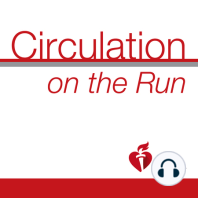16 min listen
Fellows-in-Training Podcast
ratings:
Length:
26 minutes
Released:
Jun 26, 2017
Format:
Podcast episode
Description
Dr. Carolyn Lam: Welcome to Circulation on the Run, your weekly podcast summary and backstage pass to the journal and its editors. I'm Dr. Carolyn Lam, Associate Editor from the National Heart Center and Duke National University of Singapore, and I'm just so thrilled to be joined by a co-host today and that's Dr. Amit Khera. He's the Editor of Digital Strategies for Circulation from UT Southwestern. Welcome, Amit. Dr. Amit Khera: Hi, Carolyn. Thank you for letting me participate today and we're excited about this Fit featured podcast. Dr. Carolyn Lam: We have a very special episode today. First of all, because we don't have a print issue that follows this week and so, there's no usual summaries, but we do have special guests and these are the Fellows-in-Training. Now, we sent out a call online to all the fellows to tell us a bit about themselves as well as which articles in Circulation stood out to them, and we had an overwhelming response from all over the world, of which these two fellows really stood out. So, join me in welcoming Dr. Punag Divanji from United States and Dr. Mayooran Namasivayam from Australia. Welcome. Dr. Punag Divanji: Hi, thank you so much for having us. Dr. Mayooran Namasivayam: Thank you very much. Dr. Carolyn Lam: So, Punag, could you start us off by telling us a little bit about yourself, your training, your dreams, and why you chose that particular paper from this month's Circulation that spoke to you? Dr. Punag Divanji: I'm currently a second year Cardiology Fellow, completing my General Fellowship and beginning a research year at the University of California in San Francisco. I will be pursuing research in women's health and subsequently pursuing an Interventional Cardiology Fellowship. Subsequently, this, hopefully, will lead to a career in academic Interventional Cardiology. Dr. Carolyn Lam: Now, we asked you to pick an article from Circulation. I really wonder which was your pick? Dr. Punag Divanji: I think one of the most important ones that spoke to me recently was the CVD-REAL Study, the comparative effectiveness of cardiovascular outcomes in new users of SGLT2 inhibitors. The CVD-REAL Study from Dr. Kosiborod of the Saint Luke's Mid America Heart Institute and an international group of colleagues was the first multinational retrospective observational study to compare CVD outcomes in patients with type 2 diabetes, who were prescribed sodium-glucose co-transporter 2 inhibitors or SGLT2 inhibitors. The primary objective of this study was to compare the risk of hospitalization for heart failure in patients with established type 2 diabetes that were newly initiated on SGLT2 inhibitors. Patients who were newly initiated on an SGLT2 inhibitor had a 39% lower risk of hospitalization for heart failure compared with those newly initiated on other glucose lowering drugs. There was significant geographic variation in the use of SGLT2 inhibitors, with the predominance of canagliflozin in the United States, dapagliflozin in European countries, and no more than 7% penetration of empagliflozin in any of these six countries. Despite this, there was no signs of significant heterogeneity across the countries, suggesting the cardiovascular benefits observed may be class related. In addition, the reduced risk of hospitalization for heart failure was stable across sensitivity analyses, including sequential occlusion of other glucose-lowering drugs like insulin, metformin, or even the GLP-1 receptor agonists, the only other class of drug with benefits in CVOTs. Dr. Carolyn Lam: Punag, give us an idea why this paper stand out to you. I mean, we had the EMPA-REG Outcome Trial, and I'd love to know ho
Released:
Jun 26, 2017
Format:
Podcast episode
Titles in the series (100)
Circulation June 6, 2017 Issue: Circulation Weekly: Your Weekly Summary & Backstage Pass To The Journal by Circulation on the Run
